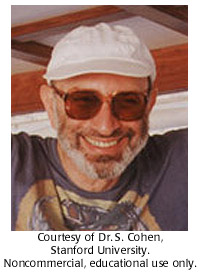Concept 34 Genes can be moved between species.


 Stan Cohen and Herb Boyer "invented" recombinant DNA technology. Doug Hanahan refined transformation methods for DNA uptake into bacteria.
Stan Cohen and Herb Boyer "invented" recombinant DNA technology. Doug Hanahan refined transformation methods for DNA uptake into bacteria.
Stanley Norman Cohen (1935-)

Stan Cohen was born in Perth Amboy, New Jersey. As a child, he was very interested in science, especially in how things worked. He built and assembled telephones, radios, and thought that he might become a physicist.
He eventually changed his mind and decided he would rather be a medical doctor. After graduating from Rutgers College in 1956, Cohen went to the University of Pennsylvania School of Medicine. He finished his medical degree in 1960.
During his residency, Cohen became more and more interested in basic research. While he was at the National Institutes of Health, he made the decision to combine basic research with clinical medicine. This would be similar to today's more formal M.D./Ph.D. programs. He accepted a position at Stanford University's medical school in 1968 and began experimenting with plasmids.
Plasmids have clinical importance because of the drug resistance genes they carry. Leslie Shiu, a graduate student in Cohen's lab, found that adding calcium chloride increases the chances that plasmid DNA would be incorporated by bacteria. Transformed bacteria would then maintain and propagate the plasmid DNA. Cohen saw the implications; this was a natural Xerox machine for DNA. If DNA could be first introduced into plasmids and then transformed into bacteria, then large quantities of DNA could be produced.
Cohen worked on ways of breaking up the plasmids, and isolating usable fragments for cloning. In 1972, at a meeting in Hawaii, Cohen sat in on a talk by Herbert Boyer, who spoke about how a restriction enzyme, EcoRI, generated sticky ends. Later that night, a group including Boyer and Cohen met up at a deli. Boyer and Cohen discussed various ways they could collaborate. Recombinant DNA technology was born on a deli napkin. Cohen and Boyer eventually patented their technique — one of the first biotech patents granted.
Cohen is a Professor of Genetics at Stanford University. He is a member of the National Academy of Sciences, and in 1980, won the Albert Lasker Basic Medical Research Award. He was awarded the National Medal of Science in 1988. He enjoys skiing, hiking, playing the five-string banjo, and sailing on his boat Genesis.


Scientists recognized the potential of recombinant DNA technology for misuse, and convened a meeting in Asilomar in 1974 to discuss the implications. Some of the current guidelines for recombinant DNA research came from this early meeting.

How could recombinant DNA technology be misused?
 DNA is packaged in a chromosome.
DNA is packaged in a chromosome. Higher cells incorporate an ancient chromosome.
Higher cells incorporate an ancient chromosome. Some DNA does not encode protein.
Some DNA does not encode protein. Some DNA can jump.
Some DNA can jump. Genes can be turned on and off.
Genes can be turned on and off. Genes can be moved between species.
Genes can be moved between species. DNA responds to signals from outside the cell.
DNA responds to signals from outside the cell. Different genes are active in different kinds of cells.
Different genes are active in different kinds of cells. Master genes control basic body plans.
Master genes control basic body plans. Development balances cell growth and death.
Development balances cell growth and death. A genome is an entire set of genes.
A genome is an entire set of genes. Living things share common genes.
Living things share common genes. DNA is only the beginning for understanding the human genome.
DNA is only the beginning for understanding the human genome.